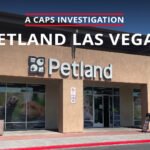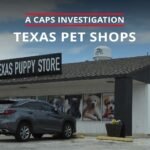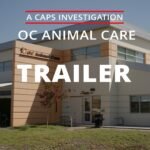Breeder: Obermark,Virginia
Business name: Obermark’s Kennel
Address: Rd 1 Box 215
City, State Zip: Pocahontas, IL 62275
Year: 2004
USDA License: 33-A-0343
USDA Inspector: Ben Flerlage, ACI
USDA Inspections: 2002-07-30 (reports unavailable after 3/04)
Date of CAPS Investigation: 2004-07-11
Prior CAPS Investivations: 2002-08-24
About 100 dogs. Breeds: Poodles, Pekingese, Yorkshire Terriers, Chihuahuas, Papillons, Shih Tzus, Maltese
The Obermarks’ kennel is behind their house near the woods behind the property. The end of the kennel closest to the house had two enclosures, one for Yorkshire Terriers and the other for Maltese and Pekingese. Both enclosures were raised 2.5 feet off the ground by wooden supports. These enclosures had plastic roofs and wire walls, bottoms, and doors. The wires on the walls and floorings were treated, while the doors were made of a large gauge wire that was untreated (3.6(a)(2)(xii)-Primary enclosures) and rusting (3.1(c)(i)-Surfaces). Each enclosure had three cages, and each cage had a wooden box for shelter. The enclosures had plastic sheets under them about a foot above the ground.
The enclosure housing the Maltese and Pekingese contained three cages. One of these cages was empty, while the other contained four Maltese. The middle cage had one Pekingese.
The second enclosure also had three cages. One cage contained four Yorkshire Terriers, another contained three, and a third contained two. All of the Yorkshire Terriers had very short fur, which appeared to have been recently shaved.
Further from the house was an enclosure identical to the one described above for Yorkshire Terriers. One of the cages of this enclosure had three Yorkshire Terriers, another contained two Yorkshire Terriers and what appeared to be a Papillon. The third cage had four Yorkshire Terriers. All of the cages had metal self-feeders and plastic water dishes.
Behind this enclosure was a similar enclosure. Two cages had two Papillons each, and the third housed three Poodles (two white and one black).
Next to these enclosures and further from the house, about 20 feet from the woods, was a concrete slab with chain link pens containing Yorkshire Terriers, Pekingese and Shih Tzus. The four pens over this slab had plastic dog houses. Even though some of the pens had plastic sheets about five feet tall and three feet wide covering the side furthest from the woods (the side facing the Obermarks’ house), the tops were completely uncovered (3.6(a)(2)(v)(vi)(vii)-Primary enclosures).
The Pekingese had large mats of hair that stuck out two to four inches from their sides and stomachs (2.40-Vet Care). Two of the Shih Tzu and two of the Pekingese had green mucous thickly covering an eye, indicative of an eye infection (2.40-Vet Care).
Next to the concrete slab and still further from the Obermarks’ house were four cages made of treated wire with untreated wire doors. A small plastic dog house at the back of each cage extended about a foot into the cage. The cages were all raised about 2.5 feet above the ground on wooden boards, and had a slanted plastic roof covering them. The cages also had metal self-feeders and plastic water containers. Each cage contained three to four Yorkshire Terriers who, like all of the other Yorkshire Terriers in the kennel, appeared to have had their fur recently shaved. Adjacent to this enclosure were two other enclosures of similar design, each containing three cages with three to four dogs each (Yorkshire Terriers and Shih Tzus). All of the enclosures described in this paragraph had slanted plastic sheets under them, presumably for catching feces and urine.
Adjacent to these, and furthest from the house, a concrete slab extended out with two pens made of chain link wiring. Inside each pen were three Maltese. The pens also had no windbreaks or coverings over their tops, and plastic dog houses (3.6(a)(2)(v)(vi)(vii)-Primary enclosures).
All of the food and water containers were full of rain water. The water in the food bowls completely soaked the small amounts of food (3.9(a)-Feeding). The food containers were not placed so as to minimize contamination by excrement (3.9(b)-Feeding). Some of the bowls were rusty or moldy (3.9-Feeding) (3.10-Watering). Water bowls had algae (3.10-Watering).
CAPS found numerous violations during its two investigations of the Obermark facility (see CAPS report for the 8/24/02 investigation). Ben Flerlage, ACI, did an inspection on 7/30/02, less than one month prior to the CAPS investigation. It is incredible that he found no violations. He failed to find any violations during the 9/18/01 inspection either. Because it is now nearly impossible to obtain USDA inspection reports due to FOIA requirements, CAPS doesn’t know if Mr. Flerlage found any violations during his 2003 and 2004 inspections. It is highly unlikely that he cited Ms. Obermark for any non-compliances, and if he did, he probably found no more than just one violation. s some very serious problems. The most alarming is the lack of veterinary care.
Download attachments:obermarkII-1.pdf
obermarkII-2.pdf
obermarkII-3.pdf
obermarkII-4.pdf
obermarkII-5.pdf




